Taxation Law Assignment - BACC318, Melbourne Polytechnic, 2018
VerifiedAdded on 2023/06/04
|8
|1755
|77
Homework Assignment
AI Summary
This document presents a comprehensive solution to a Taxation Law assignment, addressing various aspects of Australian tax law. The assignment analyzes scenarios involving depreciation of assets, general deductions, legal expenses, and tax-deductible donations. The solution meticulously applies relevant sections of the Income Tax Assessment Act 1936 and 1997, along with case law, to determine the appropriate tax treatment for each situation. The analysis includes calculations for depreciation using both diminishing value and prime cost methods, examination of nexus between expenses and assessable income, and determination of whether legal and advertisement expenses can be deducted. Furthermore, the document explores the timing of deductions, particularly in relation to future liabilities, and the eligibility of donations to community fire services. Overall, the document offers a detailed and well-referenced solution to the assignment questions, providing a valuable resource for students studying taxation law.
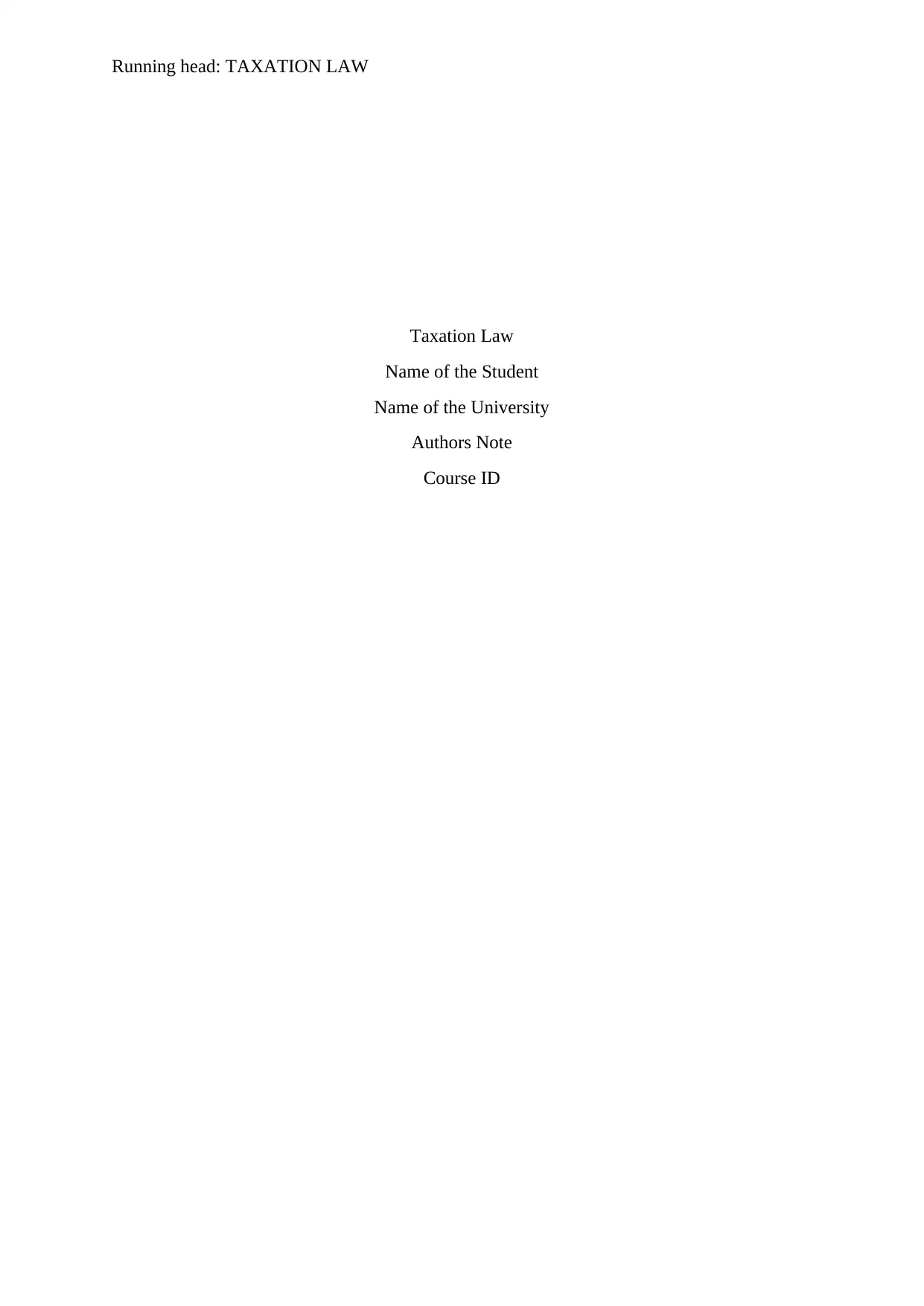
Running head: TAXATION LAW
Taxation Law
Name of the Student
Name of the University
Authors Note
Course ID
Taxation Law
Name of the Student
Name of the University
Authors Note
Course ID
Paraphrase This Document
Need a fresh take? Get an instant paraphrase of this document with our AI Paraphraser
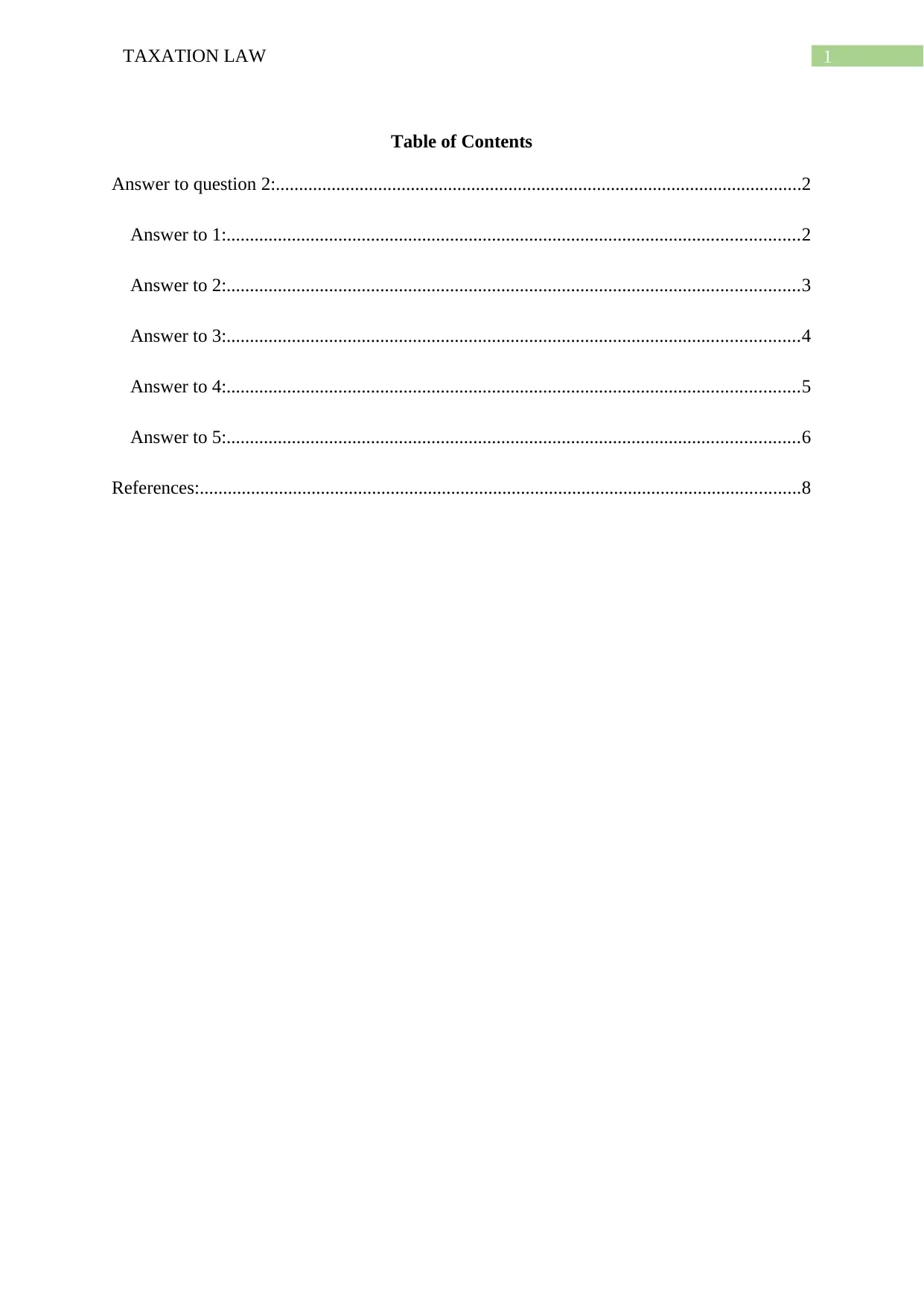
1TAXATION LAW
Table of Contents
Answer to question 2:.................................................................................................................2
Answer to 1:...........................................................................................................................2
Answer to 2:...........................................................................................................................3
Answer to 3:...........................................................................................................................4
Answer to 4:...........................................................................................................................5
Answer to 5:...........................................................................................................................6
References:.................................................................................................................................8
Table of Contents
Answer to question 2:.................................................................................................................2
Answer to 1:...........................................................................................................................2
Answer to 2:...........................................................................................................................3
Answer to 3:...........................................................................................................................4
Answer to 4:...........................................................................................................................5
Answer to 5:...........................................................................................................................6
References:.................................................................................................................................8
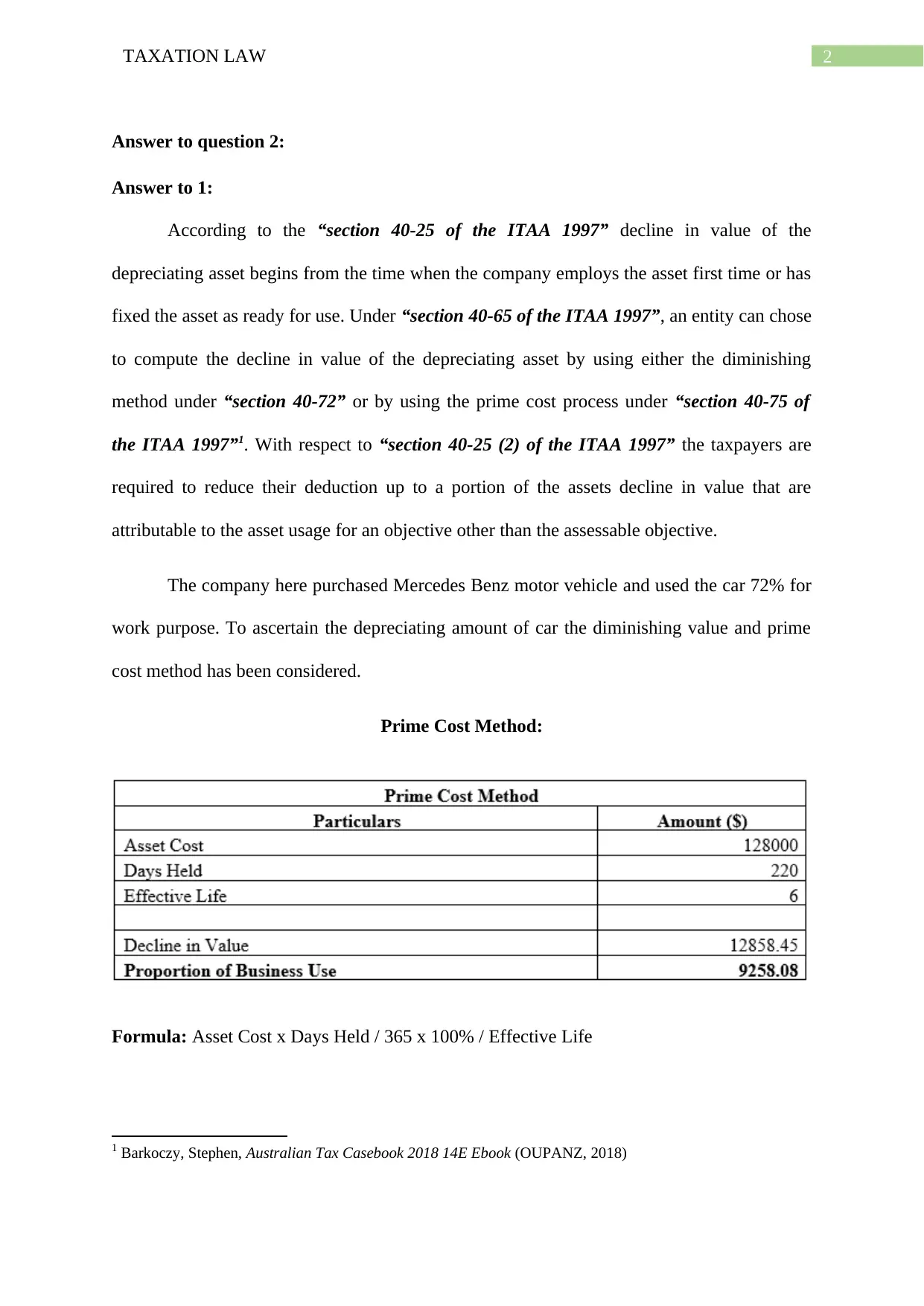
2TAXATION LAW
Answer to question 2:
Answer to 1:
According to the “section 40-25 of the ITAA 1997” decline in value of the
depreciating asset begins from the time when the company employs the asset first time or has
fixed the asset as ready for use. Under “section 40-65 of the ITAA 1997”, an entity can chose
to compute the decline in value of the depreciating asset by using either the diminishing
method under “section 40-72” or by using the prime cost process under “section 40-75 of
the ITAA 1997”1. With respect to “section 40-25 (2) of the ITAA 1997” the taxpayers are
required to reduce their deduction up to a portion of the assets decline in value that are
attributable to the asset usage for an objective other than the assessable objective.
The company here purchased Mercedes Benz motor vehicle and used the car 72% for
work purpose. To ascertain the depreciating amount of car the diminishing value and prime
cost method has been considered.
Prime Cost Method:
Formula: Asset Cost x Days Held / 365 x 100% / Effective Life
1 Barkoczy, Stephen, Australian Tax Casebook 2018 14E Ebook (OUPANZ, 2018)
Answer to question 2:
Answer to 1:
According to the “section 40-25 of the ITAA 1997” decline in value of the
depreciating asset begins from the time when the company employs the asset first time or has
fixed the asset as ready for use. Under “section 40-65 of the ITAA 1997”, an entity can chose
to compute the decline in value of the depreciating asset by using either the diminishing
method under “section 40-72” or by using the prime cost process under “section 40-75 of
the ITAA 1997”1. With respect to “section 40-25 (2) of the ITAA 1997” the taxpayers are
required to reduce their deduction up to a portion of the assets decline in value that are
attributable to the asset usage for an objective other than the assessable objective.
The company here purchased Mercedes Benz motor vehicle and used the car 72% for
work purpose. To ascertain the depreciating amount of car the diminishing value and prime
cost method has been considered.
Prime Cost Method:
Formula: Asset Cost x Days Held / 365 x 100% / Effective Life
1 Barkoczy, Stephen, Australian Tax Casebook 2018 14E Ebook (OUPANZ, 2018)
⊘ This is a preview!⊘
Do you want full access?
Subscribe today to unlock all pages.

Trusted by 1+ million students worldwide
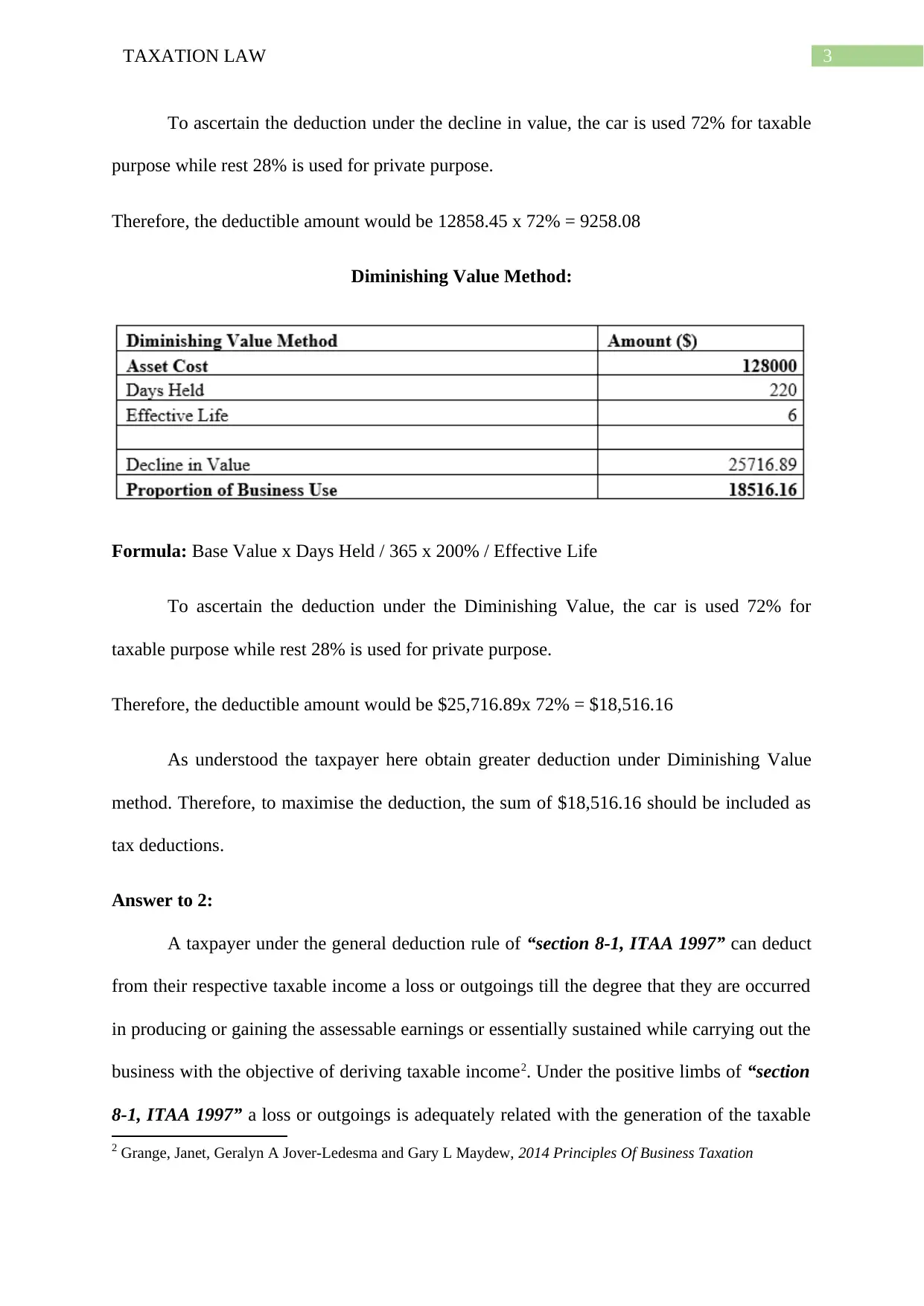
3TAXATION LAW
To ascertain the deduction under the decline in value, the car is used 72% for taxable
purpose while rest 28% is used for private purpose.
Therefore, the deductible amount would be 12858.45 x 72% = 9258.08
Diminishing Value Method:
Formula: Base Value x Days Held / 365 x 200% / Effective Life
To ascertain the deduction under the Diminishing Value, the car is used 72% for
taxable purpose while rest 28% is used for private purpose.
Therefore, the deductible amount would be $25,716.89x 72% = $18,516.16
As understood the taxpayer here obtain greater deduction under Diminishing Value
method. Therefore, to maximise the deduction, the sum of $18,516.16 should be included as
tax deductions.
Answer to 2:
A taxpayer under the general deduction rule of “section 8-1, ITAA 1997” can deduct
from their respective taxable income a loss or outgoings till the degree that they are occurred
in producing or gaining the assessable earnings or essentially sustained while carrying out the
business with the objective of deriving taxable income2. Under the positive limbs of “section
8-1, ITAA 1997” a loss or outgoings is adequately related with the generation of the taxable
2 Grange, Janet, Geralyn A Jover-Ledesma and Gary L Maydew, 2014 Principles Of Business Taxation
To ascertain the deduction under the decline in value, the car is used 72% for taxable
purpose while rest 28% is used for private purpose.
Therefore, the deductible amount would be 12858.45 x 72% = 9258.08
Diminishing Value Method:
Formula: Base Value x Days Held / 365 x 200% / Effective Life
To ascertain the deduction under the Diminishing Value, the car is used 72% for
taxable purpose while rest 28% is used for private purpose.
Therefore, the deductible amount would be $25,716.89x 72% = $18,516.16
As understood the taxpayer here obtain greater deduction under Diminishing Value
method. Therefore, to maximise the deduction, the sum of $18,516.16 should be included as
tax deductions.
Answer to 2:
A taxpayer under the general deduction rule of “section 8-1, ITAA 1997” can deduct
from their respective taxable income a loss or outgoings till the degree that they are occurred
in producing or gaining the assessable earnings or essentially sustained while carrying out the
business with the objective of deriving taxable income2. Under the positive limbs of “section
8-1, ITAA 1997” a loss or outgoings is adequately related with the generation of the taxable
2 Grange, Janet, Geralyn A Jover-Ledesma and Gary L Maydew, 2014 Principles Of Business Taxation
Paraphrase This Document
Need a fresh take? Get an instant paraphrase of this document with our AI Paraphraser
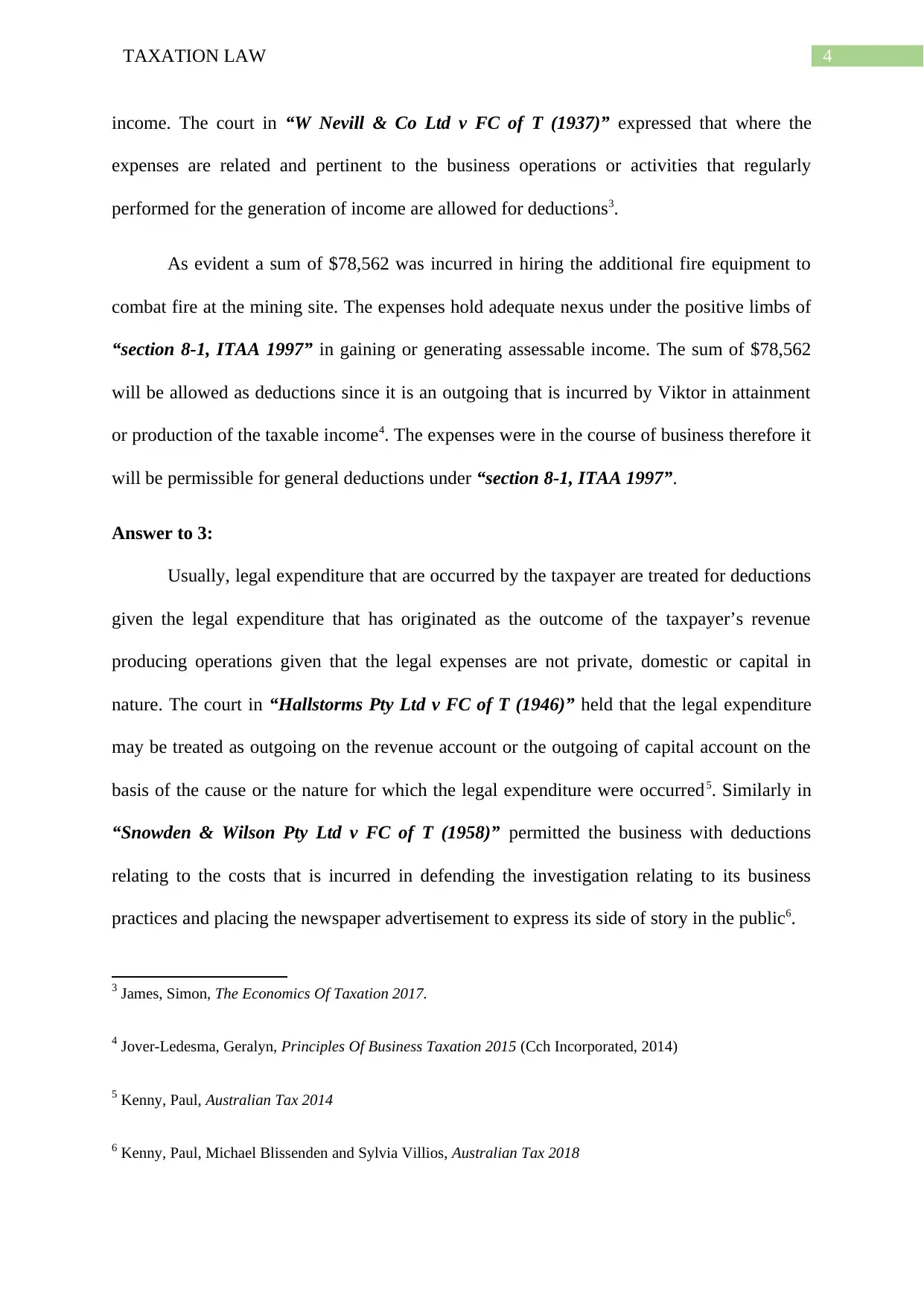
4TAXATION LAW
income. The court in “W Nevill & Co Ltd v FC of T (1937)” expressed that where the
expenses are related and pertinent to the business operations or activities that regularly
performed for the generation of income are allowed for deductions3.
As evident a sum of $78,562 was incurred in hiring the additional fire equipment to
combat fire at the mining site. The expenses hold adequate nexus under the positive limbs of
“section 8-1, ITAA 1997” in gaining or generating assessable income. The sum of $78,562
will be allowed as deductions since it is an outgoing that is incurred by Viktor in attainment
or production of the taxable income4. The expenses were in the course of business therefore it
will be permissible for general deductions under “section 8-1, ITAA 1997”.
Answer to 3:
Usually, legal expenditure that are occurred by the taxpayer are treated for deductions
given the legal expenditure that has originated as the outcome of the taxpayer’s revenue
producing operations given that the legal expenses are not private, domestic or capital in
nature. The court in “Hallstorms Pty Ltd v FC of T (1946)” held that the legal expenditure
may be treated as outgoing on the revenue account or the outgoing of capital account on the
basis of the cause or the nature for which the legal expenditure were occurred5. Similarly in
“Snowden & Wilson Pty Ltd v FC of T (1958)” permitted the business with deductions
relating to the costs that is incurred in defending the investigation relating to its business
practices and placing the newspaper advertisement to express its side of story in the public6.
3 James, Simon, The Economics Of Taxation 2017.
4 Jover-Ledesma, Geralyn, Principles Of Business Taxation 2015 (Cch Incorporated, 2014)
5 Kenny, Paul, Australian Tax 2014
6 Kenny, Paul, Michael Blissenden and Sylvia Villios, Australian Tax 2018
income. The court in “W Nevill & Co Ltd v FC of T (1937)” expressed that where the
expenses are related and pertinent to the business operations or activities that regularly
performed for the generation of income are allowed for deductions3.
As evident a sum of $78,562 was incurred in hiring the additional fire equipment to
combat fire at the mining site. The expenses hold adequate nexus under the positive limbs of
“section 8-1, ITAA 1997” in gaining or generating assessable income. The sum of $78,562
will be allowed as deductions since it is an outgoing that is incurred by Viktor in attainment
or production of the taxable income4. The expenses were in the course of business therefore it
will be permissible for general deductions under “section 8-1, ITAA 1997”.
Answer to 3:
Usually, legal expenditure that are occurred by the taxpayer are treated for deductions
given the legal expenditure that has originated as the outcome of the taxpayer’s revenue
producing operations given that the legal expenses are not private, domestic or capital in
nature. The court in “Hallstorms Pty Ltd v FC of T (1946)” held that the legal expenditure
may be treated as outgoing on the revenue account or the outgoing of capital account on the
basis of the cause or the nature for which the legal expenditure were occurred5. Similarly in
“Snowden & Wilson Pty Ltd v FC of T (1958)” permitted the business with deductions
relating to the costs that is incurred in defending the investigation relating to its business
practices and placing the newspaper advertisement to express its side of story in the public6.
3 James, Simon, The Economics Of Taxation 2017.
4 Jover-Ledesma, Geralyn, Principles Of Business Taxation 2015 (Cch Incorporated, 2014)
5 Kenny, Paul, Australian Tax 2014
6 Kenny, Paul, Michael Blissenden and Sylvia Villios, Australian Tax 2018
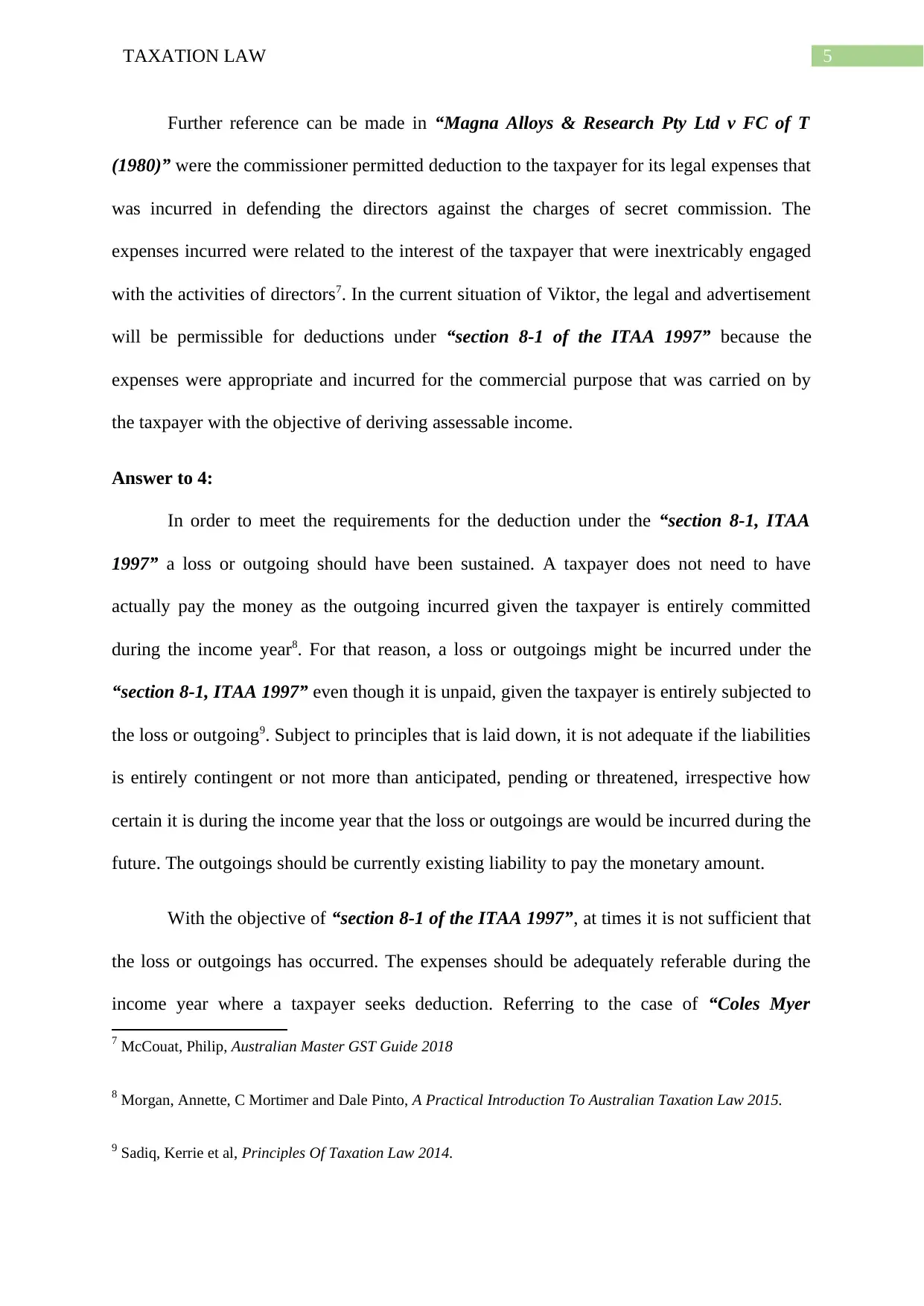
5TAXATION LAW
Further reference can be made in “Magna Alloys & Research Pty Ltd v FC of T
(1980)” were the commissioner permitted deduction to the taxpayer for its legal expenses that
was incurred in defending the directors against the charges of secret commission. The
expenses incurred were related to the interest of the taxpayer that were inextricably engaged
with the activities of directors7. In the current situation of Viktor, the legal and advertisement
will be permissible for deductions under “section 8-1 of the ITAA 1997” because the
expenses were appropriate and incurred for the commercial purpose that was carried on by
the taxpayer with the objective of deriving assessable income.
Answer to 4:
In order to meet the requirements for the deduction under the “section 8-1, ITAA
1997” a loss or outgoing should have been sustained. A taxpayer does not need to have
actually pay the money as the outgoing incurred given the taxpayer is entirely committed
during the income year8. For that reason, a loss or outgoings might be incurred under the
“section 8-1, ITAA 1997” even though it is unpaid, given the taxpayer is entirely subjected to
the loss or outgoing9. Subject to principles that is laid down, it is not adequate if the liabilities
is entirely contingent or not more than anticipated, pending or threatened, irrespective how
certain it is during the income year that the loss or outgoings are would be incurred during the
future. The outgoings should be currently existing liability to pay the monetary amount.
With the objective of “section 8-1 of the ITAA 1997”, at times it is not sufficient that
the loss or outgoings has occurred. The expenses should be adequately referable during the
income year where a taxpayer seeks deduction. Referring to the case of “Coles Myer
7 McCouat, Philip, Australian Master GST Guide 2018
8 Morgan, Annette, C Mortimer and Dale Pinto, A Practical Introduction To Australian Taxation Law 2015.
9 Sadiq, Kerrie et al, Principles Of Taxation Law 2014.
Further reference can be made in “Magna Alloys & Research Pty Ltd v FC of T
(1980)” were the commissioner permitted deduction to the taxpayer for its legal expenses that
was incurred in defending the directors against the charges of secret commission. The
expenses incurred were related to the interest of the taxpayer that were inextricably engaged
with the activities of directors7. In the current situation of Viktor, the legal and advertisement
will be permissible for deductions under “section 8-1 of the ITAA 1997” because the
expenses were appropriate and incurred for the commercial purpose that was carried on by
the taxpayer with the objective of deriving assessable income.
Answer to 4:
In order to meet the requirements for the deduction under the “section 8-1, ITAA
1997” a loss or outgoing should have been sustained. A taxpayer does not need to have
actually pay the money as the outgoing incurred given the taxpayer is entirely committed
during the income year8. For that reason, a loss or outgoings might be incurred under the
“section 8-1, ITAA 1997” even though it is unpaid, given the taxpayer is entirely subjected to
the loss or outgoing9. Subject to principles that is laid down, it is not adequate if the liabilities
is entirely contingent or not more than anticipated, pending or threatened, irrespective how
certain it is during the income year that the loss or outgoings are would be incurred during the
future. The outgoings should be currently existing liability to pay the monetary amount.
With the objective of “section 8-1 of the ITAA 1997”, at times it is not sufficient that
the loss or outgoings has occurred. The expenses should be adequately referable during the
income year where a taxpayer seeks deduction. Referring to the case of “Coles Myer
7 McCouat, Philip, Australian Master GST Guide 2018
8 Morgan, Annette, C Mortimer and Dale Pinto, A Practical Introduction To Australian Taxation Law 2015.
9 Sadiq, Kerrie et al, Principles Of Taxation Law 2014.
⊘ This is a preview!⊘
Do you want full access?
Subscribe today to unlock all pages.

Trusted by 1+ million students worldwide
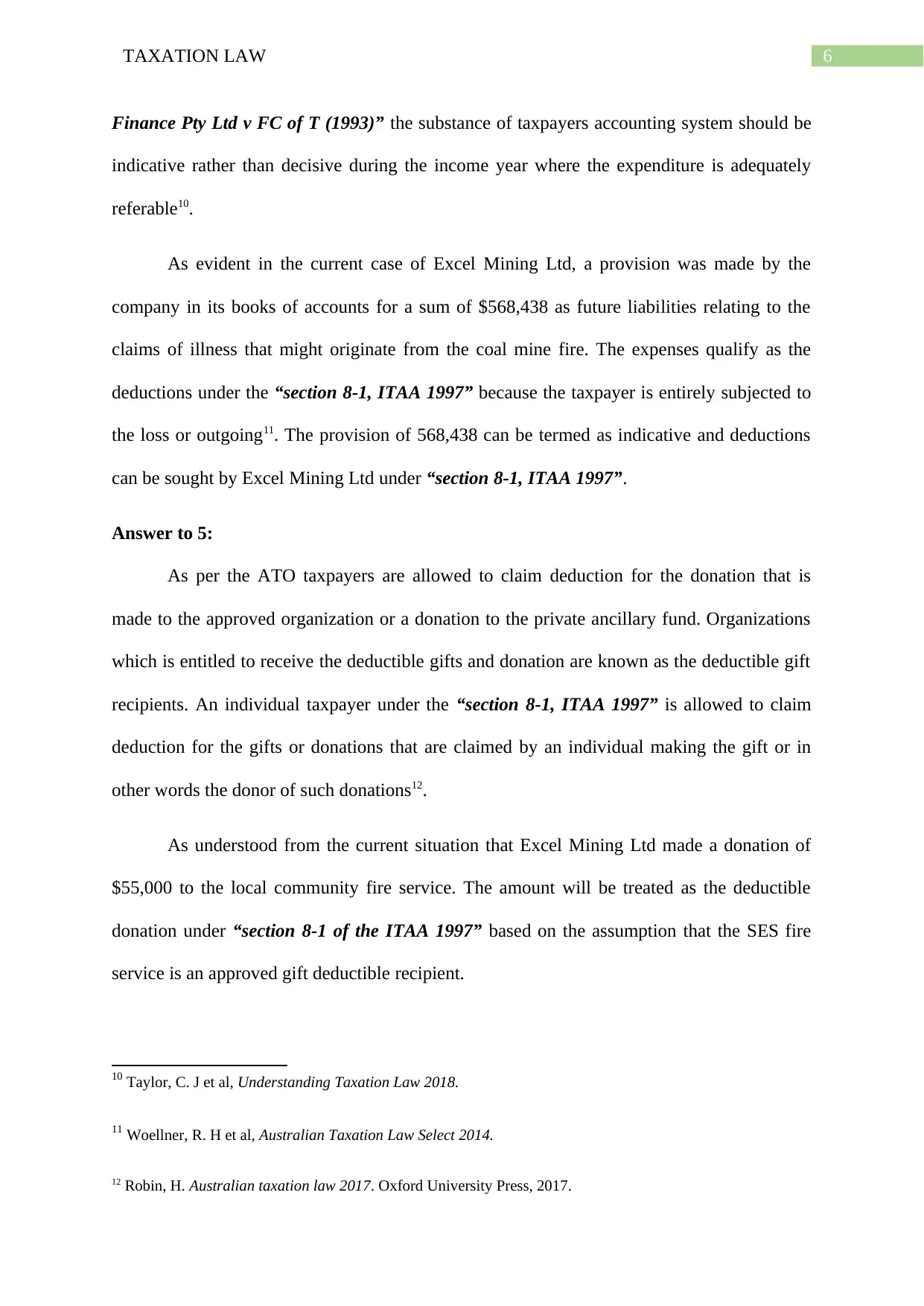
6TAXATION LAW
Finance Pty Ltd v FC of T (1993)” the substance of taxpayers accounting system should be
indicative rather than decisive during the income year where the expenditure is adequately
referable10.
As evident in the current case of Excel Mining Ltd, a provision was made by the
company in its books of accounts for a sum of $568,438 as future liabilities relating to the
claims of illness that might originate from the coal mine fire. The expenses qualify as the
deductions under the “section 8-1, ITAA 1997” because the taxpayer is entirely subjected to
the loss or outgoing11. The provision of 568,438 can be termed as indicative and deductions
can be sought by Excel Mining Ltd under “section 8-1, ITAA 1997”.
Answer to 5:
As per the ATO taxpayers are allowed to claim deduction for the donation that is
made to the approved organization or a donation to the private ancillary fund. Organizations
which is entitled to receive the deductible gifts and donation are known as the deductible gift
recipients. An individual taxpayer under the “section 8-1, ITAA 1997” is allowed to claim
deduction for the gifts or donations that are claimed by an individual making the gift or in
other words the donor of such donations12.
As understood from the current situation that Excel Mining Ltd made a donation of
$55,000 to the local community fire service. The amount will be treated as the deductible
donation under “section 8-1 of the ITAA 1997” based on the assumption that the SES fire
service is an approved gift deductible recipient.
10 Taylor, C. J et al, Understanding Taxation Law 2018.
11 Woellner, R. H et al, Australian Taxation Law Select 2014.
12 Robin, H. Australian taxation law 2017. Oxford University Press, 2017.
Finance Pty Ltd v FC of T (1993)” the substance of taxpayers accounting system should be
indicative rather than decisive during the income year where the expenditure is adequately
referable10.
As evident in the current case of Excel Mining Ltd, a provision was made by the
company in its books of accounts for a sum of $568,438 as future liabilities relating to the
claims of illness that might originate from the coal mine fire. The expenses qualify as the
deductions under the “section 8-1, ITAA 1997” because the taxpayer is entirely subjected to
the loss or outgoing11. The provision of 568,438 can be termed as indicative and deductions
can be sought by Excel Mining Ltd under “section 8-1, ITAA 1997”.
Answer to 5:
As per the ATO taxpayers are allowed to claim deduction for the donation that is
made to the approved organization or a donation to the private ancillary fund. Organizations
which is entitled to receive the deductible gifts and donation are known as the deductible gift
recipients. An individual taxpayer under the “section 8-1, ITAA 1997” is allowed to claim
deduction for the gifts or donations that are claimed by an individual making the gift or in
other words the donor of such donations12.
As understood from the current situation that Excel Mining Ltd made a donation of
$55,000 to the local community fire service. The amount will be treated as the deductible
donation under “section 8-1 of the ITAA 1997” based on the assumption that the SES fire
service is an approved gift deductible recipient.
10 Taylor, C. J et al, Understanding Taxation Law 2018.
11 Woellner, R. H et al, Australian Taxation Law Select 2014.
12 Robin, H. Australian taxation law 2017. Oxford University Press, 2017.
Paraphrase This Document
Need a fresh take? Get an instant paraphrase of this document with our AI Paraphraser
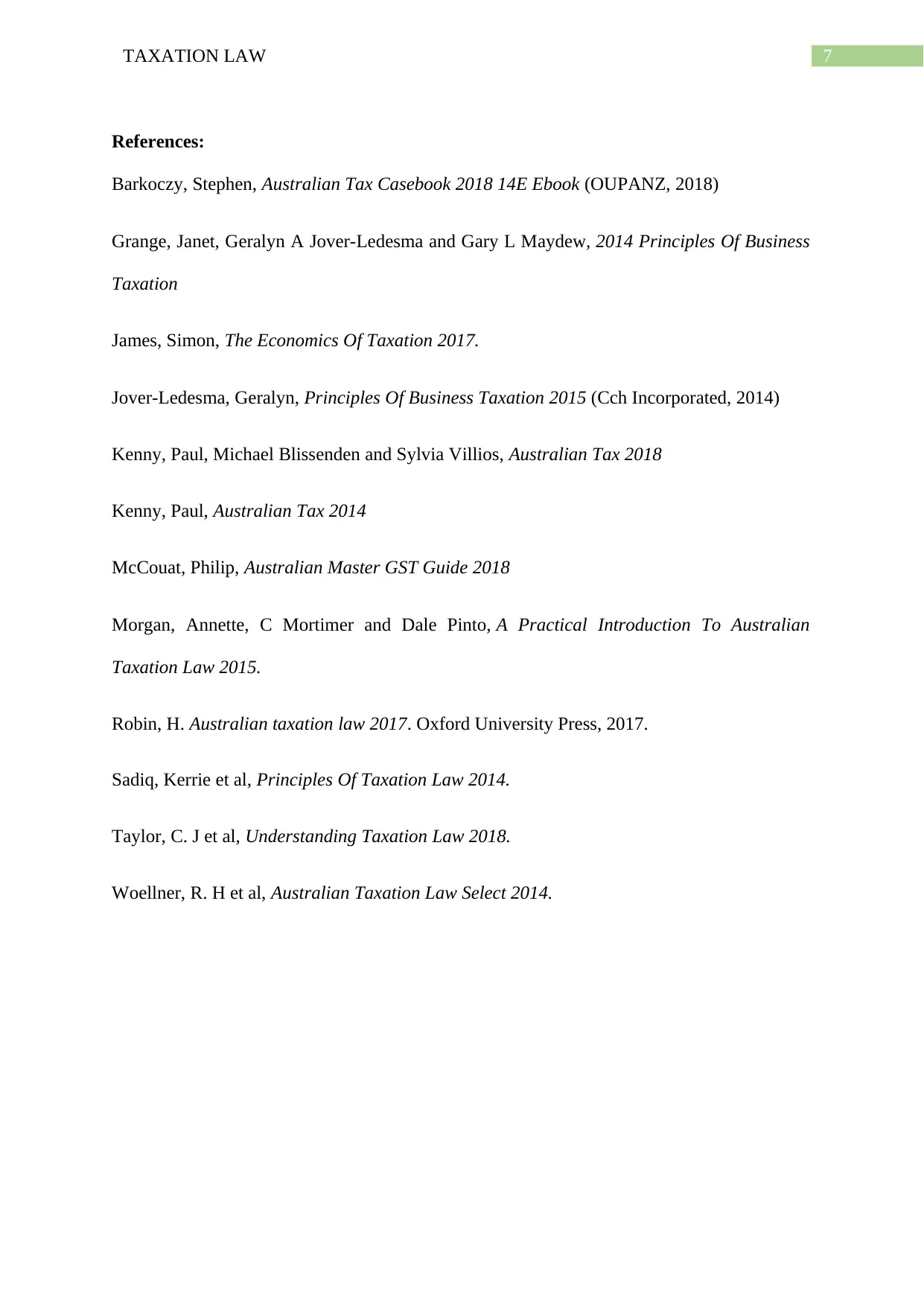
7TAXATION LAW
References:
Barkoczy, Stephen, Australian Tax Casebook 2018 14E Ebook (OUPANZ, 2018)
Grange, Janet, Geralyn A Jover-Ledesma and Gary L Maydew, 2014 Principles Of Business
Taxation
James, Simon, The Economics Of Taxation 2017.
Jover-Ledesma, Geralyn, Principles Of Business Taxation 2015 (Cch Incorporated, 2014)
Kenny, Paul, Michael Blissenden and Sylvia Villios, Australian Tax 2018
Kenny, Paul, Australian Tax 2014
McCouat, Philip, Australian Master GST Guide 2018
Morgan, Annette, C Mortimer and Dale Pinto, A Practical Introduction To Australian
Taxation Law 2015.
Robin, H. Australian taxation law 2017. Oxford University Press, 2017.
Sadiq, Kerrie et al, Principles Of Taxation Law 2014.
Taylor, C. J et al, Understanding Taxation Law 2018.
Woellner, R. H et al, Australian Taxation Law Select 2014.
References:
Barkoczy, Stephen, Australian Tax Casebook 2018 14E Ebook (OUPANZ, 2018)
Grange, Janet, Geralyn A Jover-Ledesma and Gary L Maydew, 2014 Principles Of Business
Taxation
James, Simon, The Economics Of Taxation 2017.
Jover-Ledesma, Geralyn, Principles Of Business Taxation 2015 (Cch Incorporated, 2014)
Kenny, Paul, Michael Blissenden and Sylvia Villios, Australian Tax 2018
Kenny, Paul, Australian Tax 2014
McCouat, Philip, Australian Master GST Guide 2018
Morgan, Annette, C Mortimer and Dale Pinto, A Practical Introduction To Australian
Taxation Law 2015.
Robin, H. Australian taxation law 2017. Oxford University Press, 2017.
Sadiq, Kerrie et al, Principles Of Taxation Law 2014.
Taylor, C. J et al, Understanding Taxation Law 2018.
Woellner, R. H et al, Australian Taxation Law Select 2014.
1 out of 8
Related Documents
Your All-in-One AI-Powered Toolkit for Academic Success.
+13062052269
info@desklib.com
Available 24*7 on WhatsApp / Email
![[object Object]](/_next/static/media/star-bottom.7253800d.svg)
Unlock your academic potential
Copyright © 2020–2025 A2Z Services. All Rights Reserved. Developed and managed by ZUCOL.





